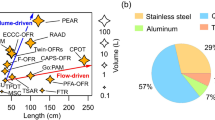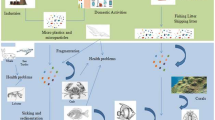Abstract
It has been well documented in in vitro studies that ambient airborne particulate matter (PM) with an aerodynamic diameter less than 2.5 μm (PM2.5) is capable of inducing oxidative stress, which plays a key role in PM2.5-mediated cytotoxicity. Although nuclear factor erythroid-2-related factor 2 (Nrf2) has been shown to regulate the intracellular defense mechanisms against oxidative stress, a potential of the Nrf2-mediated cellular defense against oxidative stress induced by PM2.5 remains to be determined. This study was aimed to explore the potential signaling pathway of Nrf2-mediated defense mechanisms against PM2.5-induced oxidative stress in human type II alveolar epithelial A549 cells. We exposed A549 cells to PM2.5 particles collected from Beijing at a concentration of 16 μg/cm2. We observed that PM2.5 triggered an increase of intracellular reactive oxygen species (ROS) in a time-dependent manner during a period of 2 h exposure. We also found that Nrf2 overexpression suppressed and Nrf2 knockdown increased PM2.5-induced ROS generation. Using Western blot and confocal microscopy, we found that PM2.5 exposure triggered significant translocation of Nrf2 into nucleus, resulting in AKT phosphorylation and significant transcription of ARE-driven phases II enzyme genes, such as NAD(P)H:quinone oxidoreductase (NQO-1), heme oxygenase-1 (HO-1), and glutamate-cysteine ligase catalytic subunit (GCLC) in A549 cells. Evaluation of signaling pathways showed that a phosphatidylinositol 3-kinase (PI3K) inhibitor (LY294002), but not an ERK 1/2 inhibitor (PD98059) or a p38 MAPK (SB203580), significantly down-regulated PM2.5-induced Nrf2 nuclear translocation and HO-1 mRNA expression, indicating PI3K/AKT is involved in the signaling pathway leads to the PM2.5-induced nuclear translocation of Nrf2 and subsequent Nrf2-mediated HO-1 transcription. Taken together, our results suggest that PM2.5-induced ROS may function as signaling molecules to activate Nrf2-mediated defenses, such as HO-1 expression, against oxidative stress induced by PM2.5 through the PI3K/AKT signaling pathway.






Similar content being viewed by others
Abbreviations
- ARE:
-
Antioxidant response element
- DCFH-DA:
-
2′, 7′-dichlorofluorescein diacetate
- ECL:
-
Enhanced chemiluminescence
- GCLC:
-
Glutamate-cysteine ligase catalytic subunit
- H2O2 :
-
Hydrogen peroxide
- HO-1:
-
Heme oxygenase-1
- Keap1:
-
Kelch-like ECH associated protein 1
- MAPK:
-
Mitogen-activated protein kinases
- NAC:
-
N-acetylcysteine
- NQO-1:
-
NAD(P)H:quinone oxidoreductase
- Nrf2:
-
Nuclear NF-E2-related factor 2
- O2·− :
-
Superoxide anion
- ·OH:
-
Hydroxyl radical
- PI3K:
-
Phosphatidylinositol 3-kinase
- PM:
-
Ambient airborne particulate matter
- ROS:
-
Reactive oxygen species
- SOD:
-
Superoxide dismutase
References
Afri M, Frimer AA, Cohen Y. Active oxygen chemistry within the liposomal bilayer: Part IV: locating 2′, 7′-dichlorofluorescein (DCF), 2′, 7′-dichlorodihydro fluorescein (DCFH) and 2′, 7′-dichlorodihydrofluorescein diacetate (DCFH-DA) in the lipid bilayer. Chem Phys Lipids. 2004;131:123–33.
Aoki Y, Sato H, Nishimura N, Takahashi S, Itoh K, Yamamoto M. Accelerated DNA adduct formation in the lung of the Nrf2 knockout mouse exposed to diesel exhaust. Toxicol Appl Pharmacol. 2001;173:154–60.
Cheng SE, Lee IT, Lin CC, Kou YR, Yang CM. Cigarette smoke particle-phase extract induces HO-1 expression in human tracheal smooth muscle cells: role of the c-Src/NADPH oxidase/MAPK/Nrf2 signaling pathway. Free Radical Bio Med. 2010;48:1410–22.
Friling RS, Bensimon A, Tichauer Y, Daniel V. Xenobiotic-inducible expression of murine glutathione S-transferase Ya subunit gene is controlled by an electrophile-responsive element. Proc Natl Acad Sci U S A. 1990;87:6258–62.
Frohlich DA, McCabe MT, Arnold RS, Day ML. The role of Nrf2 in increased reactive oxygen species and DNA damage in prostate tumorigenesis. Oncogene. 2008;27:4353–62.
Gazzano E, Turci F, Foresti E, Putzu MG, Aldieri E, Silvagno F, et al. Iron-loaded synthetic chrysotile: a new model solid for studying the role of iron in asbestos toxicity. Chem Res Toxicol. 2007;20:380–7.
Gomes A, Fernandes E, Lima JL. Fluorescence probes used for detection of reactive oxygen species. J Biochem Biophys Methods. 2005;65:45–80.
Hennessy BT, Smith DL, Ram PT, Lu Y, Mills GB. Exploiting the PI3K/AKT pathway for cancer drug discovery. Nat Rev Drug Discov. 2005;4:988–1004.
Huang HC, Nguyen T, Pickett CB. Phosphorylation of Nrf2 at Ser-40 by protein kinase C regulates antioxidant response element-mediated transcription. J Biol Chem. 2002;277:42769–74.
Huang YC, Karoly ED, Dailey LA, Schmitt MT, Silbajoris R, Graff DW, et al. Comparison of gene expression profiles induced by coarse, fine, and ultrafine particulate matter. J Toxicol Environ Health A. 2011;74:296–312.
Imrich A, Ning Y, Kobzik L. Insoluble components of concentrated air particles mediate alveolar macrophage responses in vitro. Toxicol Appl Pharm. 2000;167:140–50.
LeBel CP, Ischiropoulos H, Bondy SC. Evaluation of the probe 2', 7'-dichlorofluorescin as an indicator of reactive oxygen species formation and oxidative stress. Chem Res Toxicol. 1992;5:227–31.
Lee JM, Johnson JA. An important role of Nrf2-ARE pathway in the cellular defense mechanism. J Biochem Mol Biol. 2004;37:139–43.
Li N, Alam J, Venkatesan MI, Eiguren-Fernandez A, Schmitz D, Di Stefano E, et al. Nrf2 is a key transcription factor that regulates antioxidant defense in macrophages and epithelial cells: protecting against the proinflammatory and oxidizing effects of diesel exhaust chemicals. J Immunol. 2004;173:3467–81.
Li N, Xia T, Nel AE. The role of oxidative stress in ambient particulate matter-induced lung diseases and its implications in the toxicity of engineered nanoparticles. Free Radic Biol Med. 2008;44:1689–99.
Lieber M, Smith B, Szakal A, Nelson-Rees W, Todaro G. A continuos tumour-cell line from a human lung carcinoma with properties of type II alveolar epithelial cells. Int J Cancer. 1976;17:62–70.
Limón-Pacheco J, Gonsebatt ME. The role of antioxidants and antioxidant-related enzymes in protective responses to environmentally induced oxidative stress. Mutat Res. 2009;674:137–47.
Martin D, Rojo AI, Salinas M, Diaz R, Gallardo G, Alam J, et al. Regulation of heme oxygenase-1 expression through the phosphatidylinositol 3-kinase/Akt pathway and the Nrf2 transcription factor in response to the antioxidant phytochemical carnosol. J Biol Chem. 2004;279:8919–29.
McMahon M, Itoh K, Yamamoto M, Chanas SA, Henderson CJ, McLellan LI, et al. The Cap ‘n’Collar basic leucine zipper transcription factor Nrf2 (NF-E2 p45-related factor 2) controls both constitutive and inducible expression of intestinal detoxification and glutathione biosynthetic enzymes. Cancer Res. 2001;61:3299–307.
Mroz RM, Schins RP, Li H, Jimenez LA, Drost EM, Holownia A, et al. Nanoparticle-driven DNA damage mimics irradiation-related carcinogenesis pathways. Eur Respir J. 2008;31:241–51.
Pamplona R, Costantini D. Molecular and structural antioxidant defenses against oxidative stress in animals. Am J Physiol Regul Integr Comp Physiol. 2011;301:R843–63.
Papaiahgari S, Zhang Q, Kleeberger SR, Cho HY, Reddy SP. Hyperoxia stimulates an Nrf2-ARE transcriptional response via ROS-EGFR-PI3K-Akt/ERK MAP kinase signaling in pulmonary epithelial cells. Antioxid Redox Signal. 2006;8:43–52.
Rothen-Rutishauser B, Blank F, Mühlfeld C, Gehr P. In vitro models of the human epithelial airway barrier to study the toxic potential of particulate matter. Expert Opin Drug Metab Toxicol. 2008;4:1075–89.
Rubio V, Valverde M, Rojas E. Effects of atmospheric pollutants on the Nrf2 survival pathway. Environ Sci Pollut Res Int. 2010;17:369–82.
Ryter SW, Alam J, Choi AM. Heme oxygenase-1/carbon monoxide: from basic science to therapeutic applications. Physiol Rev. 2006;86:583–650.
Satoh H, Moriguchi T, Taguchi K, Takai J, Maher JM, Suzuki T, et al. Nrf2-deficiency creates a responsive microenvironment for metastasis to the lung. Carcinogenesis. 2010;31:1833–43.
So HS, Kim HJ, Lee JH, Park SY, Park C, Kim YH, et al. Flunarizine induces Nrf2-mediated transcriptional activation of heme oxygenase-1 in protection of auditory cells from cisplatin. Cell Death Differ. 2006;13:1763–75.
Stearns RC, Paulauskis JD, Godleski JJ. Endocytosis of ultrafine particles by A549 cells. Am J Respir Cell Mol Biol. 2001;24:108–15.
Stringer B, Imrich A, Kobzik L. Lung epithelial cell (A549) interaction with unopsonized environmental particulates: quantitation of particle-specific binding and IL-8 production. Exp Lung Res. 1996;22:495–508.
Sun G, Crissman K, Norwood J, Richards J, Slade R, Hatch GE. Oxidative interactions of synthetic lung epithelial lining fluid with metal-containing particulate matter. Am J Physiol Lung Cell Mol Physiol. 2001;281:L807–15.
Williams MA, Rangasamy T, Bauer SM, Killedar S, Karp M, Kensler TW, et al. Disruption of the transcription factor Nrf2 promotes pro-oxidative dendritic cells that stimulate Th2-like immunoresponsiveness upon activation by ambient particulate matter. J Immunol. 2008;181:4545–59.
Wottrich R, Diabaté S, Krug HF. Biological effects of ultrafine model particles in human macrophages and epithelial cells in mono-and co-culture. Int J Hyg Envir Heal. 2004;207:353–61.
Zhang DD. Mechanistic studies of the Nrf2-Keap1 signaling pathway*. Drug Metab Rev. 2006;38:769–89.
Acknowledgments
This work was supported by grants from Gong-Yi Program of China Ministry of Environmental Protection (no. 200909016), National Natural Science Foundation of China (no. 10875170), and the National Science and Technology Ministry of China (no. 2007BAC27B02-2).
Conflict of interest
All authors declare no competing financial interest.
Author information
Authors and Affiliations
Corresponding authors
Rights and permissions
About this article
Cite this article
Deng, X., Rui, W., Zhang, F. et al. PM2.5 induces Nrf2-mediated defense mechanisms against oxidative stress by activating PIK3/AKT signaling pathway in human lung alveolar epithelial A549 cells. Cell Biol Toxicol 29, 143–157 (2013). https://doi.org/10.1007/s10565-013-9242-5
Received:
Accepted:
Published:
Issue Date:
DOI: https://doi.org/10.1007/s10565-013-9242-5




